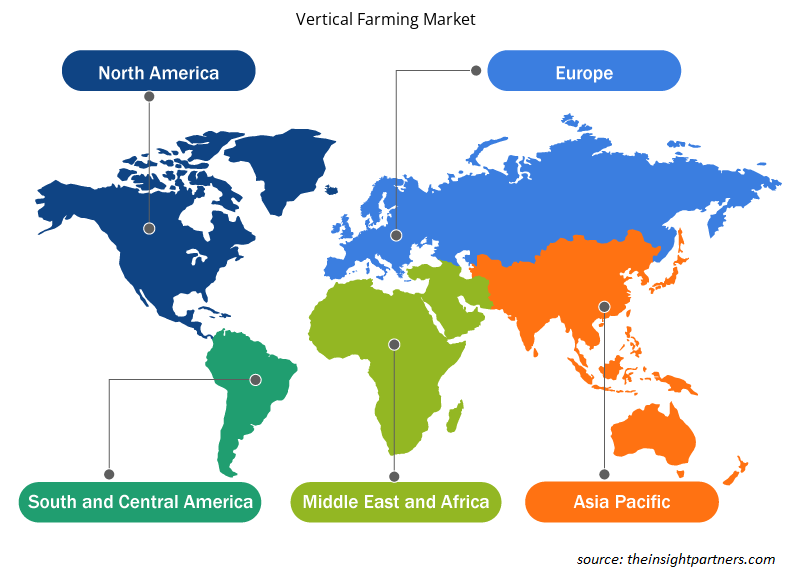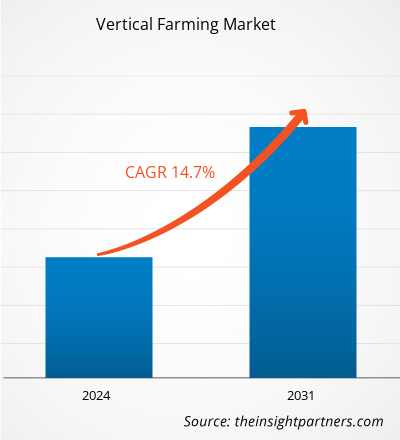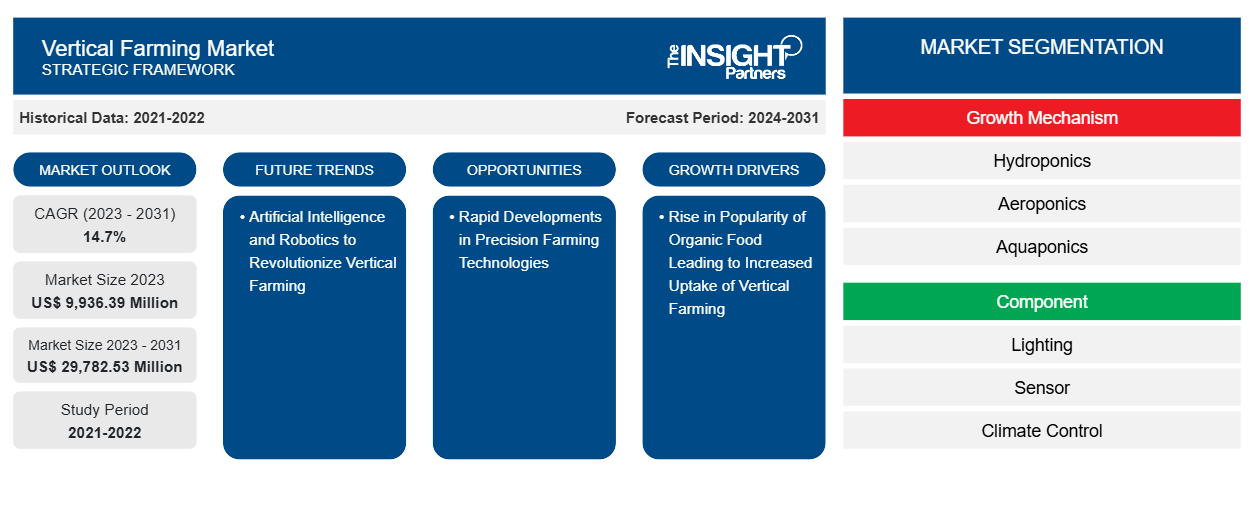垂直農法の市場規模は、2023年の99億3,639万米ドルから2031年には297億8,253万米ドルに達すると予測されています。市場は2023年から2031年の間に14.7%のCAGRを記録すると予想されています。有機食品の需要の高まりと精密農業への重点の高まりは、市場の主要なトレンドであり続けると思われます。
垂直農業市場分析
人口の増加と健康食品に対する消費者の意識の高まりが、垂直農法の大きな推進力となっています。スマート農業と精密農業への関心の高まりも、垂直農法市場に世界的にプラスの影響を与えています。認識の欠如とメンテナンスの高コストは、市場の成長を妨げる可能性のある理由の一部です。ただし、スマート農業技術に向けた政府の取り組みの拡大は、予測期間中に垂直農法の成長を促進すると予測されています。
垂直農業市場の概要
垂直農法とは、作物を垂直に育てたり積み重ねたりする方法です。このプロセス全体は、水耕栽培、空中栽培、アクアポニックスなどの方法を利用して、管理された環境で行われます。このプロセスは、従来の農法よりもはるかに少ない量の水で作物を栽培するのに役立ちます。それに加えて、垂直農法では、作物を栽培するための殺虫剤やその他の有毒な殺虫剤の必要性も減ります。都市化の拡大と人口の増加により、食糧需要が高まり、市場の原動力となっています。製薬会社も、医薬品用のバイオメディカル植物を栽培するための屋内垂直農法に注力しており、これも世界中の市場における主要な前向きなトレンドの 1 つです。
要件に合わせてレポートをカスタマイズする
このレポートの一部、国レベルの分析、Excelデータパックなど、あらゆるレポートを無料でカスタマイズできます。また、スタートアップや大学向けのお得なオファーや割引もご利用いただけます。
-
このレポートの主要な市場動向を入手してください。この無料サンプルには、市場動向から見積もりや予測に至るまでのデータ分析が含まれます。
垂直農業市場の推進要因と機会
オーガニック食品の人気の高まりが市場を後押し
健康意識の高まりと健康食品への傾向は、垂直農法市場の主な推進力となっています。消費者は、果物、野菜、穀物などの有機栽培の作物を好み、それに興味を示しています。健康意識の高まりは、有害な人工物質や化学物質を含まない食品に対する消費者の需要が高まっている主な理由の 1 つです。化学処理された作物や野菜の摂取に関連する健康被害の増加は、有機食品の主な推進力となっており、垂直農法の需要を促進しています。年間を通じて非従来型の有機栽培食品の需要が高まっていることも、世界中の市場にプラスの影響を与えています。
人工知能とロボット工学が垂直農法を変革
プロセスの自動化とロボット技術の統合に関する技術の進歩は、垂直農業市場に大きなチャンスをもたらすと予想されています。市場で活動している農場は、植物の維持管理とケアをより組織的かつ合理化された方法で進めるために、人工知能技術を導入するための研究開発活動に重点を置いています。さらに、一部の企業は、人間の介入を減らし、時間効率を高めるために、垂直農業業界へのロボットの導入にも注力しており、これも垂直農業市場の世界的成長を促進すると予測されています。
垂直農業市場レポートのセグメンテーション分析
垂直農法市場分析の導出に貢献した主要なセグメントは、製品の成長メカニズムとコンポーネントです。
- 成長メカニズムに基づいて、市場は水耕栽培、空中栽培、アクアポニックスに分けられます。水耕栽培セグメントは2023年に大きな市場シェアを占めました。
- コンポーネント別に見ると、市場は照明、センサー、気候制御、灌漑コンポーネント、建築材料、その他に分かれています。照明セグメントは2023年に市場で大きなシェアを占めました。
地域別の垂直農業市場シェア分析
垂直農業市場レポートの地理的範囲は、主に北米、アジア太平洋、ヨーロッパ、中東およびアフリカ、南米および中米の 5 つの地域に分かれています。
北米が市場をリードしています。食糧生産を増やし、一年を通して旬の果物や野菜の入手性を高めるための先進技術への多額の投資が、北米地域での垂直農法の需要を牽引しています。非従来型の有機栽培の果物、穀物、野菜の需要の高まりも、北米市場の発展を後押ししています。気温の変化や気象条件の変化は、さまざまな国で野菜や果物の生育を妨げる主な要因です。極端な気温条件の国々が、北米での垂直農法の需要を後押ししています。スペースの制約も、積み重ね式農法によって満たされており、これが垂直農法技術の採用増加の主な理由の 1 つです。農業分野における自動化の採用増加とロボット技術の増加も、この地域の垂直農法市場にプラスの影響を与えています。米国は北米の垂直農法市場をリードしています。
垂直農業市場の地域別洞察
予測期間を通じて垂直農業市場に影響を与える地域的な傾向と要因は、Insight Partners のアナリストによって徹底的に説明されています。このセクションでは、北米、ヨーロッパ、アジア太平洋、中東、アフリカ、南米、中米にわたる垂直農業市場のセグメントと地理についても説明します。

- 垂直農業市場の地域別データを入手
垂直農業市場レポートの範囲
| レポート属性 | 詳細 |
|---|---|
| 2023年の市場規模 | 99億3,639万米ドル |
| 2031年までの市場規模 | 297億8,253万米ドル |
| 世界のCAGR(2023年~2031年) | 14.7% |
| 履歴データ | 2021-2022 |
| 予測期間 | 2024-2031 |
| 対象セグメント |
成長メカニズム別
|
| 対象地域と国 |
北米
|
| 市場リーダーと主要企業プロフィール |
|
垂直農業市場のプレーヤー密度:ビジネスダイナミクスへの影響を理解する
垂直農業市場は、消費者の嗜好の変化、技術の進歩、製品の利点に対する認識の高まりなどの要因により、エンドユーザーの需要が高まり、急速に成長しています。需要が高まるにつれて、企業は提供を拡大し、消費者のニーズを満たすために革新し、新たなトレンドを活用し、市場の成長をさらに促進しています。
市場プレーヤー密度とは、特定の市場または業界内で活動している企業または会社の分布を指します。これは、特定の市場スペースに、その市場規模または総市場価値に対してどれだけの競合相手 (市場プレーヤー) が存在するかを示します。
垂直農業市場で事業を展開している主要企業は次のとおりです。
- エデングリーンテクノロジー
- エレベートファームズ株式会社
- アイファーム
- オスラム株式会社
- プレンティアンリミテッド株式会社
- スカイグリーン
免責事項:上記の企業は、特定の順序でランク付けされていません。

- 垂直農業市場のトップキープレーヤーの概要を入手
垂直農業市場のニュースと最近の動向
垂直農業市場は、主要な企業出版物、協会データ、データベースなどの一次調査と二次調査後の定性的および定量的データを収集することによって評価されます。垂直農業市場の動向のいくつかを以下に示します。
- エデン グリーン テクノロジーは、垂直農場と温室を組み合わせた施設に 1,200 万ドルを確保しました。(出典: エデン グリーン テクノロジー、プレスリリース、2024 年 3 月)
- Elevate Farms Inc. は、米国とヨーロッパの両方で垂直農法による葉物野菜の生産拠点を拡大すると発表しました。(出典: Elevate Farms Inc.、プレスリリース、2024 年 2 月)
垂直農業市場レポートの対象範囲と成果物
「垂直農業の市場規模と予測(2021〜2031年)」レポートでは、以下の分野をカバーする市場の詳細な分析を提供しています。
- 対象範囲に含まれるすべての主要市場セグメントについて、世界、地域、国レベルでの垂直農業の市場規模と予測
- 垂直農業市場の動向と、推進要因、制約、主要な機会などの市場動向
- 詳細なPESTおよびSWOT分析
- 垂直農業市場分析では、主要な市場動向、世界および地域の枠組み、主要プレーヤー、規制、最近の市場動向を取り上げています。
- 市場集中、ヒートマップ分析、主要プレーヤー、垂直農業市場の最近の動向を網羅した業界の状況と競争分析
- 詳細な企業プロフィール
- 過去2年間の分析、基準年、CAGRによる予測(7年間)
- PEST分析とSWOT分析
- 市場規模価値/数量 - 世界、地域、国
- 業界と競争環境
- Excel データセット
最新レポート
お客様の声
購入理由
- 情報に基づいた意思決定
- 市場動向の理解
- 競合分析
- 顧客インサイト
- 市場予測
- リスク軽減
- 戦略計画
- 投資の正当性
- 新興市場の特定
- マーケティング戦略の強化
- 業務効率の向上
- 規制動向への対応























 無料サンプルを入手 - 垂直農業市場
無料サンプルを入手 - 垂直農業市場